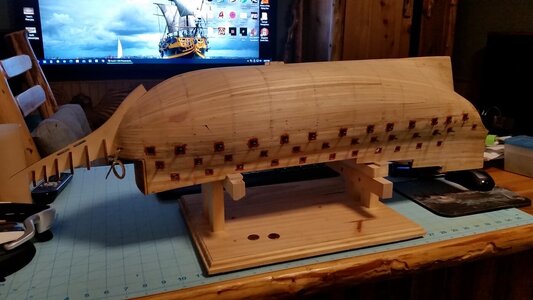Building a good model is 70% planning, 29% building, and (hopefully) 1% fixing screwups.Good morning Kurt- all above my Pay grade however awesome to read and learn both the intricacies of these ships and how think out a plan going forward. Cheers Grant
-

Win a Free Custom Engraved Brass Coin!!!
As a way to introduce our brass coins to the community, we will raffle off a free coin during the month of August. Follow link ABOVE for instructions for entering.
-

PRE-ORDER SHIPS IN SCALE TODAY!
The beloved Ships in Scale Magazine is back and charting a new course for 2026!
Discover new skills, new techniques, and new inspirations in every issue.
NOTE THAT OUR FIRST ISSUE WILL BE JAN/FEB 2026
You are using an out of date browser. It may not display this or other websites correctly.
You should upgrade or use an alternative browser.
You should upgrade or use an alternative browser.
HMS Sovereign of the Seas - Bashing DeAgostini Beyond Believable Boundaries
- Thread starter DARIVS ARCHITECTVS
- Start date
- Watchers 105
Yes, spar decks were a real thing in the 1630's. They were an alternative to nets, but may have been solid wood or wood plus netting, and you could walk on them. This was when boarding was a more common tactic and gunnery less so. That changed in the later 17th century. The Annapolis model shows the most practical guess as to what the spar deck looked like on the Sovereign if it were all wood. Take a look at the HMS Prince Royal in 1613 and you will see the spar deck with netting that sailors could still walk on. This seems to be the same method used on the Sovereign. It could be simulated with fine mesh painted to look like rope netting on the model. A lattice of very thin sticks could be used to support the netting. I imagine in real life that a lattice of 8cm x 8cm poles would provide enough support for the netting for people to confidently walk on. It would be far more difficult for boarders to cut through also than just a net. An all wood lattice like on the Annapolis model would be VERY cumbersome to erect and disassemble when you think about it. The light spars with netting over the top seems the best and most practical method.Personally I have my doubts, if a ship like the Sovereign of the Seas from the first half of 17th century had gratings over the weather deck, especially not so heavy wooden gratings.
Usually they had nets to get a protection against bording and falling sails and yards during action - the small wlakway or any other cover came as I know later.
but I found this 17th-century hand-coloured engraving by John Payne of The Sovereign of the Seas, showing seamen at this area standing or walking ?????
View attachment 320169
Sorry, but realized just now, that it is the same Maarten showed already in black and white
View attachment 320173
John McKay was already mentioned
Book review - Sovereign of the Seas 1637-John McKay
Sovereign of the Seas by John McKay 1637 Part 1 Hardcover:296 Pages Publisher:Seaforth Publishing 3rd March 2020 Language:English ISBN-10:1526766299 ISBN-13:978-1526766299 DIMENSIONS:254x295x25mm RRP:£40 SYNOPSIS Sovereign of the Seas was probably the most lavishly decorated warship ever...shipsofscale.com
In Hendrik Busmans book about the ornaments is this sketch shown
View attachment 320172
No.55 says "Grätingsdeck über der Kuhl" translated like "deck of gratings over the waist"
Book review - Book Review: "SOVEREIGN OF THE SEAS - Die Skulpturen des britischen Königsschiffes von 1637" by Hendrik Busmann
Book Review: SOVEREIGN OF THE SEAS - Die Skulpturen des britischen Königsschiffes von 1637 by Hendrik Busmann Gebundene Ausgabe: 311 Seiten Verlag: CONVENT Hamburg (2002) Sprache: Deutsch ISBN-10: 3934613195 ISBN-13: 978-3934613195 Verpackungsabmessungen: 27,4 x 21,5 x 3 cm / 1.580...shipsofscale.com
Here some photos showing the model of the Kriegstein collection - in exhibition in the USNA - United States Naval Academy Museum in Anapolis, Maryland
The model was built between 1918 and 1920, by Henry Culver and Paul Chalfin. So it is not a contemporary model.
View attachment 320174
View attachment 320170
View attachment 320171
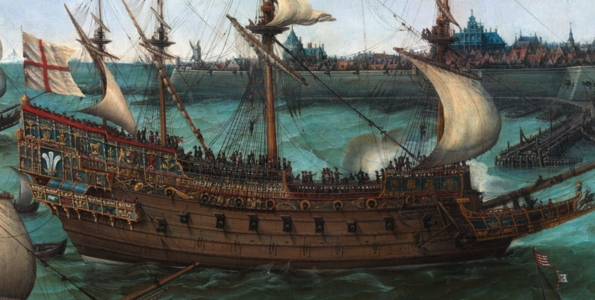
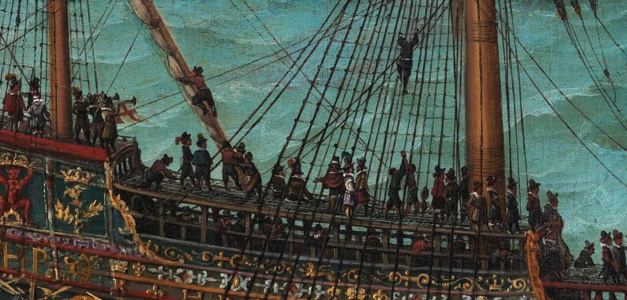
Hey.. check out all the funny hats. They DID like their hats back then, didn't they?
I noticed this too. NO LADDERS between the waist and upper forecastle, and only one door leading into the forecastle. This is on another English man of war from the painting from 1613. Good circumstantial information to use.
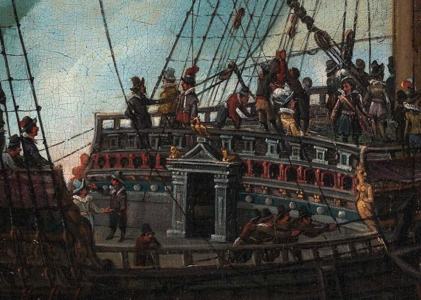
Last edited:
Thank you Uwek! You always come through with lots of information and it is so very appreciated!Personally I have my doubts, if a ship like the Sovereign of the Seas from the first half of 17th century had gratings over the weather deck, especially not so heavy wooden gratings.
Usually they had nets to get a protection against bording and falling sails and yards during action - the small wlakway or any other cover came as I know later.
but I found this 17th-century hand-coloured engraving by John Payne of The Sovereign of the Seas, showing seamen at this area standing or walking ?????
View attachment 320169
Sorry, but realized just now, that it is the same Maarten showed already in black and white
View attachment 320173
John McKay was already mentioned
Book review - Sovereign of the Seas 1637-John McKay
Sovereign of the Seas by John McKay 1637 Part 1 Hardcover:296 Pages Publisher:Seaforth Publishing 3rd March 2020 Language:English ISBN-10:1526766299 ISBN-13:978-1526766299 DIMENSIONS:254x295x25mm RRP:£40 SYNOPSIS Sovereign of the Seas was probably the most lavishly decorated warship ever...shipsofscale.com
In Hendrik Busmans book about the ornaments is this sketch shown
View attachment 320172
No.55 says "Grätingsdeck über der Kuhl" translated like "deck of gratings over the waist"
Book review - Book Review: "SOVEREIGN OF THE SEAS - Die Skulpturen des britischen Königsschiffes von 1637" by Hendrik Busmann
Book Review: SOVEREIGN OF THE SEAS - Die Skulpturen des britischen Königsschiffes von 1637 by Hendrik Busmann Gebundene Ausgabe: 311 Seiten Verlag: CONVENT Hamburg (2002) Sprache: Deutsch ISBN-10: 3934613195 ISBN-13: 978-3934613195 Verpackungsabmessungen: 27,4 x 21,5 x 3 cm / 1.580...shipsofscale.com
Here some photos showing the model of the Kriegstein collection - in exhibition in the USNA - United States Naval Academy Museum in Anapolis, Maryland
The model was built between 1918 and 1920, by Henry Culver and Paul Chalfin. So it is not a contemporary model.
View attachment 320174
View attachment 320170
View attachment 320171
Where do you guys find out all this information?, I've been misguidedly using the Sovereign of the Seas 1637 book thinking it was accurate. The next build I undertake I will definitely have to do more research but wheres the best place to start?.Thank you Uwek! You always come through with lots of information and it is so very appreciated!
- Joined
- Aug 8, 2019
- Messages
- 5,546
- Points
- 738

Here in this forum, start a buildlog and ask what you want to know. The answers will come.I will definitely have to do more research but wheres the best place to start
Start HERE, searching for build logs of the ship of interest. We scour the bowels of the internet and libraries, and some visit museums and bring back photos from ship-related sources like old paintings. We also gather information from the collections of other builders. I found that answers to questions come faster with questions on the forum than pouring through piles of books, but you get most of your information from those books. We share book references and book reviews on the forum also, so you get lots of information on where to find more books to add to your personal reference shelf. The forum can also help you determine if a certain model ship kit feature is accurate historically. All you need to do is post questions, which newcomers often fear to do for some reason. For me, this forum is my version of social media, without the useless stupidity you see on TikTok.Where do you guys find out all this information?, I've been misguidedly using the Sovereign of the Seas 1637 book thinking it was accurate. The next build I undertake I will definitely have to do more research but wheres the best place to start?.
Scour the Bowels would be an excellent band name.Start HERE, searching for build logs of the ship of interest. We scour the bowels of the internet and libraries, and some visit museums and bring back photos from ship-related sources like old paintings. We also gather information from the collections of other builders. I found that answers to questions come faster with questions on the forum than pouring through piles of books, but you get most of your information from those books. We share book references and book reviews on the forum also, so you get lots of information on where to find more books to add to your personal reference shelf. The forum can also help you determine if a certain model ship kit feature is accurate historically. All you need to do is post questions, which newcomers often fear to do for some reason. For me, this forum is my version of social media, without the useless stupidity you see on TikTok.
Well, we have SOME stupidity . . .Scour the Bowels would be an excellent band name.
Kurt,
Spent some time catching up - As always very well researched work!! -
Regards,
Spent some time catching up - As always very well researched work!! -
Regards,
Thanks buddy! I'm in the doldrums again, trying to figure out what to do next. I don't know what goes inside the forecastle on the main deck. I know that they have to cook their food there, and the galley is in there, but how to construct the oven and other interior parts? I have no idea what things look like in there. Any ideas are welcome. The same goes for the interior of the half deck and later the quarterdeck. The idea is to have the ship's interior ready for action, so most if not all of the interior dividing walls would have been dismantled or folded out of the way of the guns. There are many later examples, such as HMS Victory, but aside from Wasa, no examples to base the interior decoration off for a Baroque era ship.Kurt,
Spent some time catching up - As always very well researched work!! -
Regards,
Incredible close-ups, Kurt! I will add these to my archives.Yes, spar decks were a real thing in the 1630's. They were an alternative to nets, but may have been solid wood or wood plus netting, and you could walk on them. This was when boarding was a more common tactic and gunnery less so. That changed in the later 17th century. The Annapolis model shows the most practical guess as to what the spar deck looked like on the Sovereign if it were all wood. Take a look at the HMS Prince Royal in 1613 and you will see the spar deck with netting that sailors could still walk on. This seems to be the same method used on the Sovereign. It could be simulated with fine mesh painted to look like rope netting on the model. A lattice of very thin sticks could be used to support the netting. I imagine in real life that a lattice of 8cm x 8cm poles would provide enough support for the netting for people to confidently walk on. It would be far more difficult for boarders to cut through also than just a net. An all wood lattice like on the Annapolis model would be VERY cumbersome to erect and disassemble when you think about it. The light spars with netting over the top seems the best and most practical method.
View attachment 320217
View attachment 320219
Hey.. check out all the funny hats. They DID like their hats back then, didn't they?
I noticed this too. NO LADDERS between the waist and upper forecastle, and only one door leading into the forecastle. This is on another English man of war from the painting from 1613. Good circumstantial information to use.
View attachment 320220
Good morning Kurt- I’m going to have to rethink my percentages.....especially the 1%. . Got plenty of the redos at present. God advice tho Thanks. Cheers GrantBuilding a good model is 70% planning, 29% building, and (hopefully) 1% fixing screwups.
It’s like a stealer plank.Got a lot of planking done today while watching the Horatio Hornblower series again. Not surprised that it's going faster after doing the two decks below it for practice. There are only a few more strakes left on the starboard side, including margin plank, which takes the longest. The plank sections of the deck were scraped with a hand scraper holding a razor blade to even all the plank edges out. Two stern castle frames were reduced in size also, which makes it easier to get my fingers in there when it's time to work on the stern quarters.
More DESTRUCTION!
View attachment 319335
View attachment 319336
Fitting deck plank ends into the margin plank takes a lot of time. The faint pencil line on the margin plank shows where the margin plank will be cut away to acep the end of the loose deck plank.
View attachment 319337
Progress so far.
View attachment 319338
View attachment 319339
I like your third hand. It looks like a robot.The three ladders which lead from the upper gun deck, or weather deck, to the middle gun deck were assembled and installed. The uppermost sections of the bannisters need to be added to each ladder after the deck is planked. The bannisters used were model railroad parts, because I cannot make such small, delicate structures in wood, and one of the details I was not able to make on La Couronne was detailed ladders. These parts are a good solution. The turned wooden spindles in all kits I have seen are many times too large in scale, and an alternative was required. The parts were painted in the theme colors of the ship as originally constructed in 1637, black and gold. The bannisters were attached to Amati wood ladders using CA glue, and the ladders were custom cut to fit each ladderway. As I build this model, I imagine myself walking the decks within, and it's a thrill to see it come to life, since no one will ever see a ship like the HMS Sovereign of the Seas ever, except in our dreams. That's why the so much work has been devoted to the inside decks of the ship.
Painting plastic railroad diorama stair bannisters.
View attachment 318858
Ladders for the aft weather deck and waist.
View attachment 318859
Painting bannisters for the lower forecastle ladder.
View attachment 318860
Forecastle ladder.
View attachment 318861
Ladders installed in the hull.
View attachment 318862
It’s actually USEFUL social media.Start HERE, searching for build logs of the ship of interest. We scour the bowels of the internet and libraries, and some visit museums and bring back photos from ship-related sources like old paintings. We also gather information from the collections of other builders. I found that answers to questions come faster with questions on the forum than pouring through piles of books, but you get most of your information from those books. We share book references and book reviews on the forum also, so you get lots of information on where to find more books to add to your personal reference shelf. The forum can also help you determine if a certain model ship kit feature is accurate historically. All you need to do is post questions, which newcomers often fear to do for some reason. For me, this forum is my version of social media, without the useless stupidity you see on TikTok.
It occurred to me that much of what went into constructing HMS Sovereign of the Seas first went into building the HMS Prince Royal. I knew of a painting,Incredible close-ups, Kurt! I will add these to my archives.
The Arrival of the Elector Frederick V of the Palatinate and Elizabeth Stuart in flushing on 29 April 1613 by Hendrick Cornelisz Vroom, and found a high resolution copy of it HERE. You have to click or "Original File" to get the full sized image. There are several other great ship art pictures there also, so dig around in that link and see what you come up with. Suffice to say, high resolution images of European paintings are scarce of the internet, and zooming in will review ship details like the makeup of spar decks and other features. If you surf the web hard enough, and get clever using a search engine, you can find some gems once in a while.
Last edited:
I picked up this folder which contains small parts containers off Amazon and started using it for blocks, deadeyes, and all the other small ship modelling parts. It sits on the bookshelf when not it use. A sliding locking level and lid edges of the compartments that overlap the sides of each box ensure that tiny parts won't leak out of the boxes and prevents them from being accidentally opened.
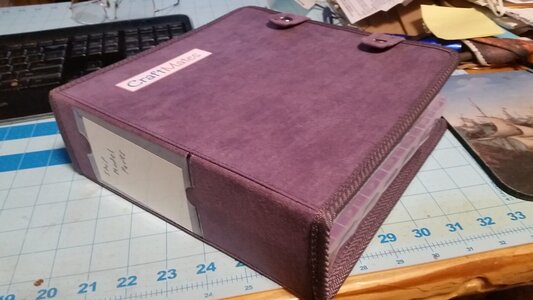
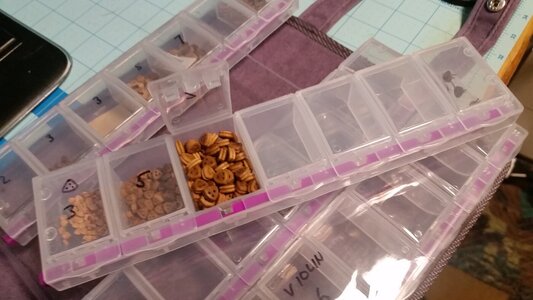
Some small but delicate work was done on the ladderways. I picked up some tiny 0.6mm model detailing chain from the hobby store, not knowing what I would use it for, but knowing it was too cool to pass up. It's used for small scale plastic model battleships. I was pondering how to finish the ladder railings when I remembered having the chain. So, after resizing the loops on some eyebolts, three sets of safety chains were made and installed on the weather deck. Perhaps they are too modern, but the ship needs to be able to grate over the ladder in the main deck in bad weather, so making safety chains as guards around open hatches and these ladders makes sense. If they are too modern, and one of you fellows knows more about what type of railings should go there from some historical reference, I could always replaced them and use the chain for something else. I'm hoping one of you has pictures of an old painting of the ladders on a 17th century ship somewhere.
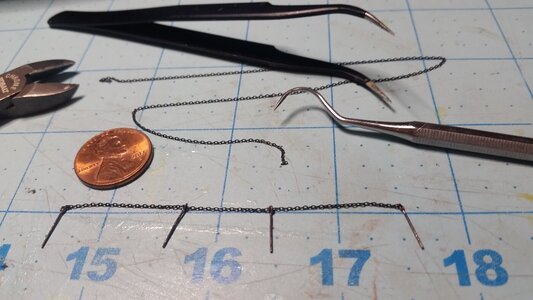
Aft weather deck ladder.
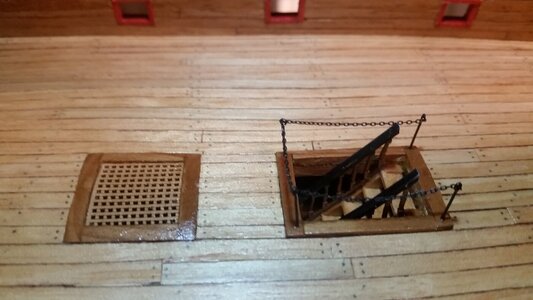
Central ladder in the waist, next to the main hatch.
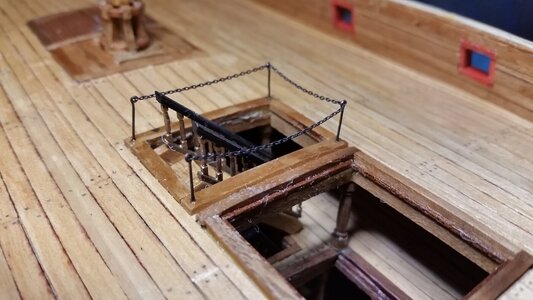
Forecastle ladder
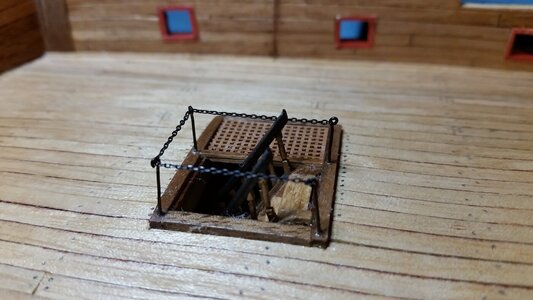
Progress so far.
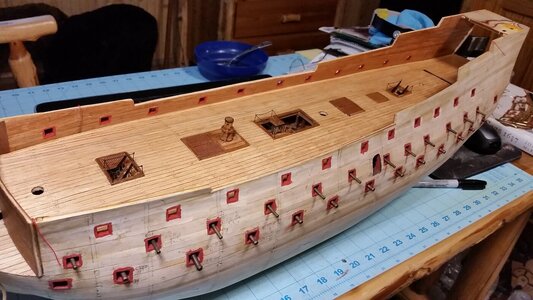


Some small but delicate work was done on the ladderways. I picked up some tiny 0.6mm model detailing chain from the hobby store, not knowing what I would use it for, but knowing it was too cool to pass up. It's used for small scale plastic model battleships. I was pondering how to finish the ladder railings when I remembered having the chain. So, after resizing the loops on some eyebolts, three sets of safety chains were made and installed on the weather deck. Perhaps they are too modern, but the ship needs to be able to grate over the ladder in the main deck in bad weather, so making safety chains as guards around open hatches and these ladders makes sense. If they are too modern, and one of you fellows knows more about what type of railings should go there from some historical reference, I could always replaced them and use the chain for something else. I'm hoping one of you has pictures of an old painting of the ladders on a 17th century ship somewhere.

Aft weather deck ladder.

Central ladder in the waist, next to the main hatch.

Forecastle ladder

Progress so far.

Last edited:
Hello shipmates! I found where you can buy that tiny chain from. It's on Amazon HERE!
I'm visiting that link now, and it is as good as visiting the painting in-person! WOW - THANKS!!





